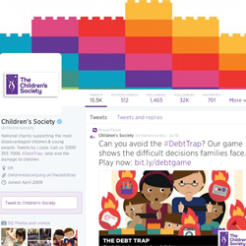The Children's Society has been creating a digital culture. It hasn't been easy, but it has been worth it, says Emma Callagher.
Alan Bennett once said that there ought to be a sign outside the National Gallery that said ‘you don’t have to like it all’. I love this idea, and in fact, wish I had been familiar with it when I worked at the Arts Council.
At the time, I felt that we were obsessed with getting everyone to like everything.
Often, we saw accessibility as the main barrier, and if only we could make art more accessible, then more people would engage with it.
While there is something to be said for this, simply making something available does not mean that everyone will suddenly and enthusiastically embrace it.
The same is very much true of embedding digital in a traditional organisation.
At the Children’s Society, our approach to digital a few years ago was probably not unlike many others who knew they had to do something digital, but were perhaps not ready to commit wholeheartedly.
I think I can sum it up as: ‘put it online’. It was broadcast only, and very much a one-way conversation with users. We knew we needed to change – we also knew that we certainly didn’t want to be left behind.
So we started our journey towards a digital-first culture with user research, and user-centred design.
Research was and is, absolutely the key; it provided us with valuable insight, enabled us to learn more about our audiences, and how to better serve them online.
Initially, this was a communications-led strategy, working to build and engage the audience first, before moving to convert them to donate, volunteer, campaign and so on. We developed a digital operating approach that is focused primarily on the user and their needs and requirements.
When working with fundraising, we apply the same user-centred test-and-learn strategy.
We aim to work with the respective teams, at as early a stage as possible, so digital and social can be integrated into their plans.
Digital can increase the number of touchpoints for the user, offer them more choice and improve the ease of access.
Recognising that digital and mobile users will have different needs and prompts means we can adapt and tailor our content accordingly.
This can be something as simple as improving our online forms, or a more involved task like AB testing different versions of our donation pages. In essence, we are continuously learning, testing, monitoring, reiterating and testing again.
All of this research led us to develop the following digital principles (with a nod to the gov.uk design principles) that can be quickly and easily understood:
- Put users at the heart of the digital experience
- Make our digital presence easily found and experienced – by everyone
- Share – and shape – our development and progress as we go along
- Enable and encourage audience engagement
- Promote a flexible and responsive digital culture
- Use fresh thinking and bold approaches to tackle digital challenges
Overcoming a lack of digital literacy
How we engage with our external audiences, though, is only half the story.
It soon became apparent that despite a wealth of enthusiasm for digital, we needed to address a shortfall in digital literacy internally.
This was brought home to me rather bluntly when chatting to some new staff about social media. When I asked one of them if they were on Facebook or Twitter, I was quite stiffly informed ‘no’ and that they ‘had a real life, thank you’.
Initially, I was amused at this notion of the digital team living in some sort of cross between Second Life (remember that?) and World of Warcraft. But I also realised that we couldn’t change our digital strategy and expect significant, consistent change if we didn’t bring the rest of the organisation with us.
While they don’t have to like it all, they do have to engage with digital on a level appropriate to their role.
We developed our new principles and operating approach with this very much in mind – I didn’t want to end up with a long, technical strategy paper, destined to be forgotten in some dusty corner of the intranet.
So, we consulted across the organisation, ran workshops, and also undertook a digital skills audit, which was sent to every member of staff. This was a significant but necessary undertaking – we wanted to bring people along willingly, not drag them behind us.
As a result, we’ve developed a number of training packages, and also started our popular Digital Lunch Bytes sessions, where external and internal speakers come and talk about wide-ranging digital subjects.
The topics are decided upon by staff – they tell us what they would like to learn about, and we then facilitate that learning. Just as we monitor and track our external progress using all the usual tools, we apply the same evaluation to our internal engagement, so we can test, respond, and improve.
Embedding digital in any organisation is not an easy, overnight task. It takes time and commitment and buy-in at all levels, but it is worth the effort.
So where are we now? We’re aware that we’re on a long journey, and that we will have to keep moving, because the landscape keeps changing. We are still moving though, still testing and learning. I might perhaps hesitate to say with absolute confidence that we have become a digital first organisation, though I can say that we are definitely one who wants to be, and that we’re absolutely on our way.









